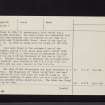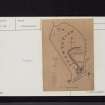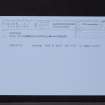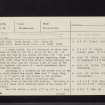Cuninghar
Cist(S) (Bronze Age), Cup And Ring Marked Stone (Prehistoric), Stone Circle (Neolithic) - (Bronze Age), Food Vessel Urn(S) (Bronze Age)
Site Name Cuninghar
Classification Cist(S) (Bronze Age), Cup And Ring Marked Stone (Prehistoric), Stone Circle (Neolithic) - (Bronze Age), Food Vessel Urn(S) (Bronze Age)
Alternative Name(s) Tillicoultry
Canmore ID 48255
Site Number NS99NW 1
NGR NS 9254 9709
NGR Description NS 9254 9709 and NS 9256 9710
Datum OSGB36 - NGR
Permalink http://canmore.org.uk/site/48255
- Council Clackmannan
- Parish Tillicoultry (Clackmannanshire)
- Former Region Central
- Former District Clackmannan
- Former County Clackmannanshire
NS99NW 1 9254 9709.
(NS 9256 9708) Stone Circle (NR) (Site of)
(NS 9257 9710) Stone Cists found (AD. 1898) (NAT)
OS 6"map, (1959)
A stone circle, the two diameters of which were estimated in 1898 as 106' NW - SE by 96' NE - SW. At that date the site of the circle (NS 9254 9709) was shown by one remaining stone (NS 9256 9708) (five feet from which a large cinerary urn was found in 1894) and the visible sites of some of the others, together with part of a small embankment which ran round the circle.
According to a forester on the estate none of the stones which formed the circle was over 3' high; they were 4' to 5' apart and were broken up for building stones and some used to cover a water-pen near Tillicoultry House in the mid-19th century. According to the ONB (1862) a large stone formerly stood in the centre of the circle.
Near the centre, a cist, 4'9" by 2'6" by 2' deep was found in 1894 (Robertson, Black and Struthers 1895) containing a food vessel and a contracted skeleton. The cover-stone was ornamented with cup and ring markings and was removed to the edge of a footpath near Tillicoultry House, where it was seen in 1927 (RCAHMS 1933). In 1898 an empty cist was found (Coles 1899) (NS 9255 9709).
Urns were found at the extreme N end of the Cunninghar, beyond D many years before 1898. In January 1914 (PSAS 1914) a food vessel is described as found about 150 yards N of the discovery of the urn in 1895 (? 1894). Further fragments of cinerary urn (probably from this sandpit) were donated to the NMAS in 1938 (PSAS 1938). The 1894 urn was also donated to the NMAS.
Name Book 1862; R Robertson, G F Black and J Struthers 1895; F R Coles 1899; Proc Soc Antiq Scot 1914; 1938; RCAHMS 1933, visited 1927.
The site of the discoveries has been destroyed by a sand-pit. The discovery of "Stone Cists"(sic) has been re-sited to NS 9256 9708 from the plan in Coles (1899). No information relating to more than one cist found in 1898 was encountered during investigation. The other was found close by in 1894.
Visited by OS (J L D) 12 January 1954.
NS 9240 9751. Coverstone of cist situated 10 yards NW of NW corner of Tillicoultry House Cottage at E side of path. Visited by Morris in 1966, but no markings are now to be seen on it.
R W B Morris 1969; Information from Ms notes of R W B Morris.
The food vessel, found in 1914, was donated to the Natioal Museum of Antiquities (NMAS) in 1962-3 by the Hon Mrs Wardlaw Ramsay.
Proc Soc Antiq Scot 1965.
Field Visit (26 July 1927)
Cist Cover, Tillicoultry House.
This stone formed the cover of a cist discovered in the sand quarry which now occupies the site of the stone circle referred to in No. 61[9]. It was removed many years ago to its present position at the edge of a footpath near Tillicoultry House. At that time the surface showed distinct traces of a number of sculpturings, including rings and spirals, but these designs have become so much weather-worn that they cannot now be discerned. The stone, which is of grey diorite, measures 7 feet 2 inches in length by 4 feet 4 inches in width and about 2 feet in greatest thickness. A food-vessel, a cinerary urn, and a number of white pebble were recovered from the grave of which the slab formed the cover, and which was "exactly where the centre of the circle must have been." The joints of the cist had been "carefully packed with clay." Other urns of cinerary type have, from time to time, been discovered on the same site, one of them "alongside of where one of the standing stones seems to have been." Cf. Proc. Soc. Ant. Scot., xxix (1894-5), pp. 190-3.
RCAHMS 1933, visited 26 July 1927.
Field Visit (26 July 1927)
"Druidical Temple," Cunninghar.
This site is an elevated ridge of sand and gravel about half a mile east of the village of Tillicoultry, on the north side of the public road to Dollar. A stone circle, measuring about 60 feet in diameter, once stood here but was completely removed many years ago, when the stones, which are said to have been about 5 ½ feet in average height, were taken to cover a built drain at Tillicoultry House. The site is now used as a sand and gravel quarry. Cf. Proc. Soc. Ant. Scot., xxix (1894-5), p. 190.
RCAHMS 1933, visited 26 July 1927.
Note (1978)
Cunninghar NS 925 970 NS99NW 1
A stone circle, said to measure about 18m in diameter and consisting of stones about 1.7m in average height, was destroyed at the end of the 19th century. In 1894 a cinerary urn (NMAS no. EA 140) was found ‘near the edge of the circle alongside where ne of the stones seems to have been’; a cist containing a food vessel (NMAS no. EE 154) and a crouched inhumation was discovered near the centre of the circle; the cover slab, which bore cup-and-ring markings, is now close to the former stables of Tillicoultry House (NS 924 975), but the decoration is no longer visible. In 1898 an empty cist was discovered within the central area of the circle. In 1914 a further Food Vessel (NMAS no. EE 155) was found in a fragmentary cist about 150m N of the site. A further food vessel was found in sand-digging in 1937 (NMAS no. L 1970.4) and an otherwise unrecorded cinerary urn was donated to the National Museum of Antiquities of Scotland in 1938 (NMAS no. EA 224)
RCAHMS 1978
(Stat Acct, xv, 1795, 214; Robertson, Black and Struthers 1895; PSAS, xxix, 1894-5, 105, no.3; Coles 1899, 358-65; PSAS, xlviii, 1913-14, 337-8; RCAHMS 1933, pp/326-7, nos.617 and 619; PSAS, lxxii, 1937-8, 273, no.4; Young 1938, 145; PSAS.xcvi, 1962-3, 364, no. 11; Morris 1968, 69, no.136)














